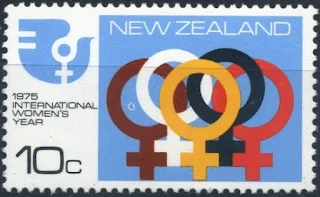
This 1975 Commemorative stamp issue commemorated the anniversaries identified below. The 40th Anniversary of the New Zealand Crippled Children's Society (Inc) and the 50th Anniversary of the Women's Division Federated Farmers of New Zealand Inc (designed by V Jepsen), and International Women's Year and Centenary of the Otago Medical School (designed by Allan Mitchell).
Four stamps by two designers have given us an issue that stands out among the issues of the 1970s. The stamps have a very simple format too. A large colourful design with a white section down the left side showing each organization's symbol, title and dates of the anniversary being celebrated.
3c - New Zealand Cripplied Children's Society 40th Anniversary.
The New Zealand Crippled Children's Society (Inc).
The New Zealand Crippled Children's Society was founded in 1935, with the aim and object to see that every crippled child has the earliest possible treatment, followed where necessary with the most effective continuous care; to assist parents to a true understanding of the child's special needs, and to inspire hope and confidence both in parent and in child; to help each crippled child to obtain a sound vocational training, and so take his or her place in the community; and to encourage in employers an attitude favourable to the employment of cripples.
The New Zealand Crippled Children's Society was founded in 1935, with the aim and object to see that every crippled child has the earliest possible treatment, followed where necessary with the most effective continuous care; to assist parents to a true understanding of the child's special needs, and to inspire hope and confidence both in parent and in child; to help each crippled child to obtain a sound vocational training, and so take his or her place in the community; and to encourage in employers an attitude favourable to the employment of cripples.
5c - Women's Division Federated Farmers 50th Anniversary.
Women's Division Federated Farmers of New Zealand Inc.
The movement began in 1925 when a group of 16 farmers' wives, on holiday in Wellington while their husbands were attending a conference of the Farmers' Union (now the Federated Farmers), became concerned with the hardships of farmers' wives and families living in isolated and backblock areas. They formed a group which has now grown into the second largest women's organisation in New Zealand. This organisation has its own emergency housekeeper service for country women in time of sickness. Rest and holiday homes have been established throughout the country to enable country women to take a rest at moderate cost and in congenial surroundings. Amongst these are "Scotlands" at Auckland, "Te Kiteroa" at Waimate, and "Melrose" at Nelson.
10c - United Nations International Womens Year.
International Women's Year.
1975 was designated by the United Nations as International Women's Year in order to focus attention on the position of women throughout the world. In New Zealand extensive programmes to promote the aims of International Women's Year were undertaken by many organisations and sections of the community.
18c - Centenary of Otago Medical School.
Centenary of the Otago Medical School.
For the first 50 years or so of settlement, New Zealand's population relied entirely on doctors who had been trained overseas. Today the majority of medical practitioners in this country have received their medical training in New Zealand. The University of Otago was established by 1870, and in 1875 a medical school was in existence. At first only the first two years of a medical course was provided with students having to complete their studies and obtain their medical qualifications at some other school of medicine. From 1885 onwards it became possible to complete the whole medical course in Dunedin, and the first student to do so was William Ledingham Christie who qualified in 1887. The first woman to complete the medical course at Dunedin was Emily Siedeberg.
This is a First Day Cover on a standard NZ Post Cover.
These covers could be used for the First Day of any issue.
This First Day Cover was prepared for this particular issue.
Errors Found in this Issue.
1975 3c Crippled Children selvage block of four with pre printing creases
causing colour shift & non printed areas.
1975 3c Crippled Children with dark orange colour shift.
Left-hand Stamp - 1975 5c Womens Division Federated Farmers,
A black 1mm colour shift downwards best seen in the outline of the figures.
Right-hand Stamp - 1975 5c Womens Division Federated Farmers.
A selvage single with the dark blue colour omitted.
1975 5c Womens Division Federated Farmers.
The purple blue colour has shifted 1mm up leaving a 1mm thick white bar
through entire Mountains in the background.
1975 10c Anniversaries with flaw in brown ring caused by foreign matter on plate.
Technical information
Date of Issue:
| 5 February 1975 |
|---|---|
Designers:
| V Jepsen, Christchurch and A G Mitchell, Wellington |
Printers:
| Harrison and Sons, England |
Stamp Size:
| 40.5mm x 25mm |
Sheet Size:
| 100 stamps per sheet |
Process:
| Lithography |
| Perforation/Gauge: | 14 x 13 |
Paper Type:
| Harrison and Sons, unwatermarked |
Some of the images in this post were used with permission from the illustrated catalogue of StampsNZ
You can visit their web site and On-line Catalogue at, http://stampsnz.com/
Information for this post came from.












We appreciate your engagement with our content. To ensure a respectful and constructive community, please take note of the following:
- No Spam, Please: We do not tolerate spammy or promotional comments. Any such comments will be promptly removed.
- Moderation in Place: All comments are moderated to maintain a positive and inclusive environment. Please be patient, as it may take a little time for your comment to appear.
- Sign In with Google: To comment, please sign in using your Google account. This helps us maintain the integrity of our community and allows for better interaction.